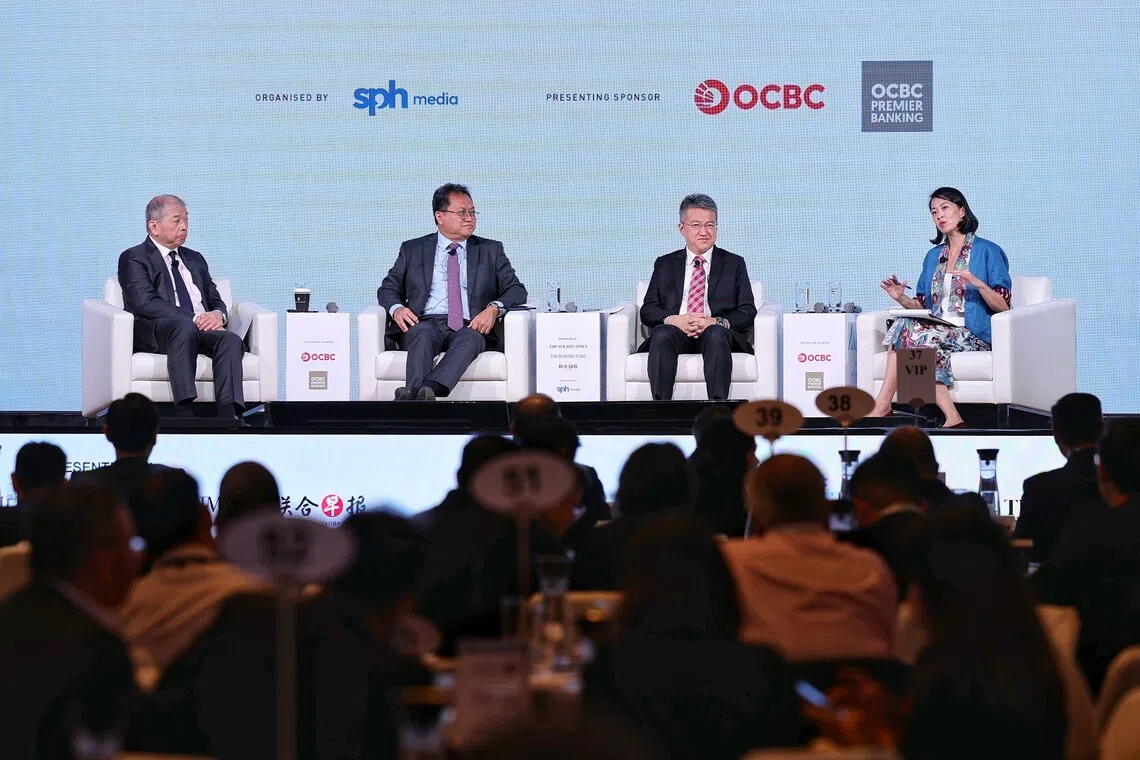Asean must deepen integration as its export-led model loses steam: Panellists at Asia Future Summit
Sign up now: Get insights on Asia's fast-moving developments

(From left) Mr Teo Siong Seng, Pacific International Lines executive chairman and Singapore Business Federation chairman; Dr Yose Rizal Damuri, executive director of Indonesia’s Centre for Strategic and International Studies; and Mr Liew Chin Tong, Malaysia’s Deputy Minister of Investment, Trade and Industry; at a panel discussion moderated by ST foreign editor Li Xueying during the Asia Future Summit on Oct 9.
ST PHOTO: KEVIN LIM
Follow topic:
- Asean must evolve beyond a manufacturing hub to become a significant consumer and believe in its own companies, according to Malaysian minister Liew Chin Tong.
- Asean needs deeper integration and should look at the Johor-Singapore Special Economic Zone as an example of closer regional cooperation, said Mr Teo Siong Seng.
- Dr Yose Rizal Damuri stated that Asean must address social inequality by creating quality jobs and revisit forming a single market to reduce non-tariff barriers.
AI generated
SINGAPORE – Asean must start taking itself more seriously and move beyond being a production hub for others if it is to thrive in a world marked by rising protectionism and shifting global power, said observers at the Asia Future Summit on Oct 9.
At a panel discussion on the region’s economic future, they cautioned that South-east Asia’s longstanding export-led model, which powered its growth for decades, is losing momentum.
This comes amid US tariffs, technological disruption and the rise of artificial intelligence – forces that are reshaping global trade flows.
One of the three panellists was Malaysia’s Deputy Minister of Investment, Trade and Industry Liew Chin Tong.
He said the region must start imagining a future – say, in 20 years’ time – where it is not merely a manufacturing hub for the world but also a significant consumer of goods and services.
“I want Asean to take Asean very seriously. I want Asean to believe in Asean more, and to believe in our own companies a lot more, to believe in our people a lot more,” said Mr Liew.
He was responding to a question from The Straits Times foreign editor Li Xueying, who moderated the discussion on the present reality of Asean and what the grouping could become.
The Asia Future Summit
The other two panellists were Mr Teo Siong Seng, Pacific International Lines executive chairman and Singapore Business Federation chairman, and Dr Yose Rizal Damuri, executive director of Indonesia’s Centre for Strategic and International Studies.
Mr Liew said the economic model of export-led industrialisation to the US, which has served the region well for half a century, “is coming to an end”.
Asean’s prosperity, he explained, was driven by competition to attract investors by cutting wages and environmental standards.
He said this approach had turned into a “race to the bottom”, built on the assumption that the United States would keep absorbing the region’s exports.
But now, Washington has raised barriers through trade tariffs and other measures, Mr Liew noted, and is effectively telling others not to export there without paying a price.
He called on Asean governments to focus on nurturing regional multinational companies and to work towards a common industrial policy that would allow the grouping to compete on its own terms.
“Maybe in 10, 15 years, we have a mini Huawei or mini Samsung or a mini TSMC,” he said, referring to successful tech companies that have sprung up in other parts of Asia.
“And it is possible that if we put our heads together, we put a policy together, and we take a different policy path.”
Echoing the call for Asean to chart its own path, Mr Teo said the region’s vast potential remains constrained by fragmentation and uneven development. The region’s 700 million-strong market, he noted, is still “very fragmented”.
“You look at the 58 years from the initial five countries, we don’t move as one... We all have a different dream,” said Mr Teo, referring to the grouping founded in 1967 by Indonesia, Malaysia, the Philippines, Singapore and Thailand.
He recalled how, more than two decades ago, there were discussions about specialisation among member economies, such as how potentially, Malaysia could specialise in agriculture, while Thailand could specialise in car parts – but such plans have “gone out the window”.
Today, Asean members compete for the same investors instead of complementing one another. Mr Teo said that while businessmen like the region and want to invest in it, it is very divided.
He suggested that the region look to the Johor-Singapore Special Economic Zone as an example of closer regional cooperation. Agreed upon in January by Malaysia and Singapore
“We can expand it and (make that) an example to see how Asean can work together to really make ourselves more confident,” said Mr Teo.
ST’s Ms Li noted that when the US announced new tariffs
Mr Teo noted that US President Donald Trump was good at “divide and rule”, but while income gaps across the region make unity challenging, Asean has demonstrated greater cohesion in other areas.
This, he said, included trade talks with China, such as negotiations for an upgraded free trade agreement.
Mr Teo added that countries must ensure less developed members are not left behind. Singapore, he said, believes that there is “no point to do well if your neighbours are not doing well”.
Responding to a question from Ms Li about what factors could influence the region’s outlook, Dr Yose said social and economic inequality remained among the biggest sources of unrest in South-east Asia.
To address such discontent, he added, countries must first tackle these underlying structural issues. “One of the most important and crucial ones is the ability of the economy to provide quality job opportunities,” said Dr Yose.
Expanding on this point, he said Asean could guard against “might is right” dynamics by coordinating on economic security policies, such as shared frameworks for investment screening, access to critical minerals, and technology transfers.
Establishing a common definition of economic security, he said, would help prevent member states from taking unilateral actions, as Indonesia had done with its critical minerals export restrictions.
He also noted that Asean must find ways to respond collectively to China’s industrial overcapacity challenge.
Instead of each country negotiating separately, they could respond collectively, using regional frameworks such as the Asean Single Window or common standards for industries such as steel and solar panels to ensure imports meet the region’s needs and sustainability goals.
Responding to a member of the audience who asked how leaders could be persuaded to pursue long-term economic reforms when “the impact will be seen only after the current government is gone”, Mr Liew said Asean could not afford to delay collective action despite domestic political uncertainties.
The region is now at an opportune time, he said, noting that issues once considered politically sensitive, such as industrial overcapacity, are increasingly being discussed more openly, even in China.
When asked how Asean should conduct itself as it looks to the future, Mr Liew said the region must stop “racing to the bottom” and instead build an inclusive economy that benefits its people.
He said the grouping’s first priority should be to act defensively and prevent “Gen Z protests”
The second, Mr Liew added, is to ensure that the region “gets rich before it gets old”. The third is to build a broad middle class that can sustain long-term growth.
Asean, he noted, still enjoys a demographic advantage over North-east Asia, with a relatively young population, but that edge will narrow in the coming decades.
“We must ensure that in the next 20 years, our people become a lot more richer before we get old,” he said.
He later added: “We can have 700 million population, but (a) 700 million population of poor people doesn’t help to create a market.”



